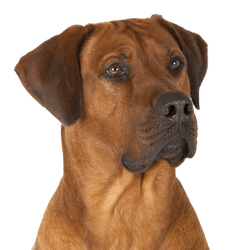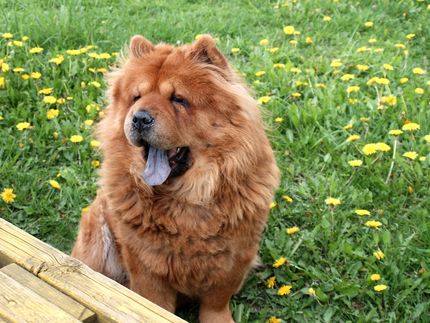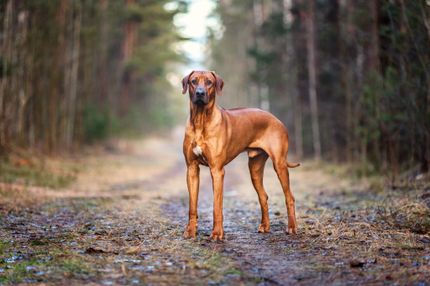Facts & Origin
The crossbreed of Rhodesian Ridgeback and Magyar Vizsla combines two fascinating and historically significant dog breeds. To understand the history and origin of this hybrid, one must look at the individual histories of both breeds.
When these two breeds are crossed, the result is a hybrid breed that combines the proud African roots of the Ridgeback and the regal Hungarian history of the Vizsla. It is a crossbreed that is valued for both its working abilities and family affection. Since it is a crossbreed, the exact time and place of its first purposeful breeding may be difficult to determine. But it is obvious that this combination combines the remarkable hunting abilities of both parent breeds in one animal.What are breed characteristics of this mix dog?

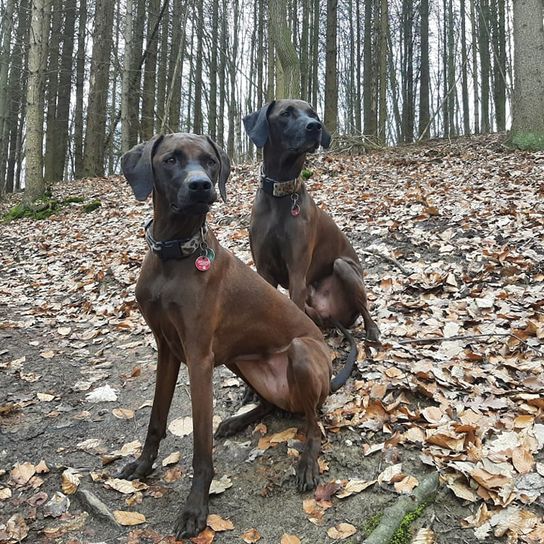
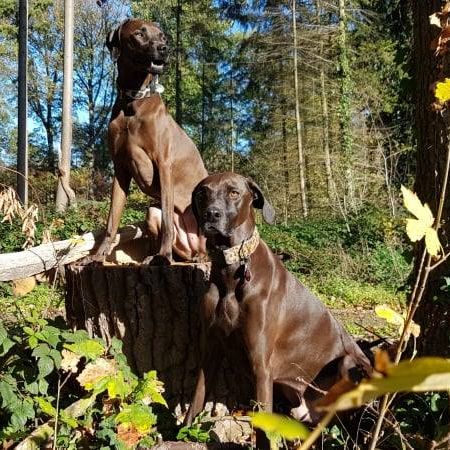

| Alternate Name | - |
| Origin | Hungary - South Africa |
| Life expectancy | 10 - 15 years |
| Care requirements | low-maintenance |
| Activity level | average to high |
| FCI group | not recognised |
| AKC group | not recognised |
| KC group | not recognised |
More Magyar Vizsla mixes
More Rhodesian Ridgeback mixes
Attitude, character and temperament of the breed
Possible character traits of Rhodesian Ridgeback and Magyar Vizsla mix - Such is probably his nature.
Combining the Rhodesian Ridgeback with the Magyar Vizsla results in a dog with an impressive mix of traits. While individual personalities may vary, here are some general traits that could appear in this mixed breed:
Loyalty and attachment: both parent breeds are known for their deep bonds with their humans. Such a mongrel could be extremely loyal and seek closeness to its family. The Vizsla is often referred to as the "Velcro Dog" because it is so affectionate. This trait could also be dominant in the mongrel.
Hunting Instinct and High Energy: Both the Rhodesian Ridgeback and the Vizsla are known for their hunting instincts. The Mongrel could therefore have a strong hunting instinct that requires regular exercise and mental stimulation.
Intelligence and Ability to Learn: Vizslas are particularly intelligent and eager to please, making them quick learners. Combined with the cleverness of the Ridgeback, this mix could be a very smart dog that responds well to training.
Cautious nature: The Rhodesian Ridgeback can sometimes be reserved or wary of strangers. It is possible for a mixed breed to exhibit this trait, while still being friendly and open with proper socialization.
Alertness: the Ridgeback has been used not only as a hunting dog, but also as a guard dog. This protective instinct, combined with the Vizsla's alertness, could make the mix a watchful companion.
Affection: Vizslas are known for their affection and love of physical closeness. It wouldn't be surprising if the Mix was a great "lap dog" that loves physical closeness with its humans.
Character
Usage
What diseases can occur in Rhodesian Ridgeback and Magyar Vizsla mix.
The health of a mixed breed dog can be affected by that of its parent breeds. Therefore, when considering a Rhodesian Ridgeback and Magyar Vizsla mix, it is helpful to know the potential health problems of both breeds:
- Hip Dysplasia: Both the Rhodesian Ridgeback and Magyar Vizsla can be susceptible to hip dysplasia. This is a condition in which the femoral head does not fit snugly into the acetabulum, which can lead to arthritis.
- Elbow Dysplasia: Another joint condition that can occur in both breeds is elbow dysplasia, in which the development of the elbow joint is impaired.
- Degenerative Myelopathy: This is a progressive disease of the spinal cord that can cause paralysis. It can occur in both breeds, especially the Rhodesian Ridgeback.
- Hypothyroidism: a disease of the thyroid gland that can cause hair loss, weight gain, and other symptoms can occur in both breeds, especially the Vizsla.
- Epilepsy: The Vizsla may be prone to epilepsy, a neurological disorder that causes seizures.
- Allergies: Both breeds can develop allergies to certain foods, environmental factors or medications.
- Heart disease: The Rhodesian Ridgeback may be susceptible to certain heart conditions, including aortic stenosis.
- Progressive Retinal Atrophy: A condition in which the cells of the retina of the eye degenerate may occur in the Vizsla, resulting in blindness.

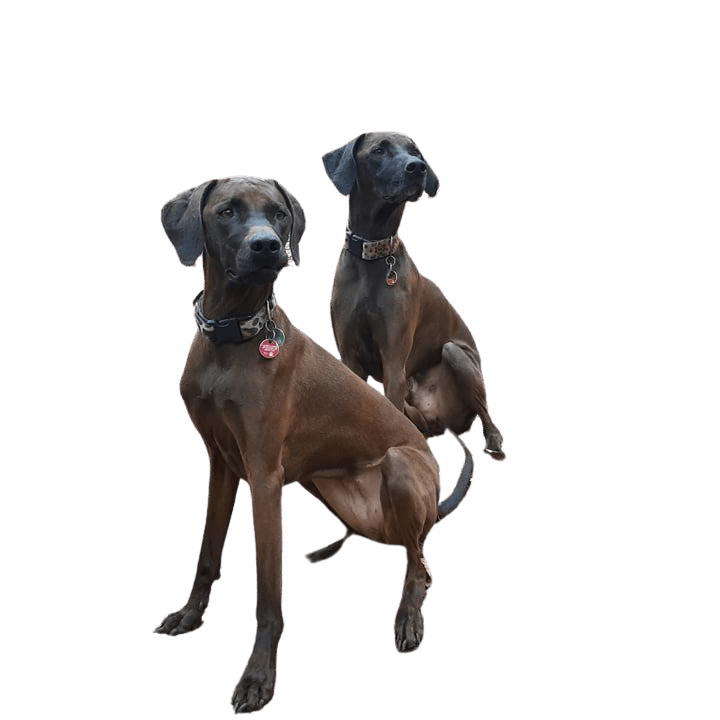
What does this mongrel look like?
The appearance of a mixed breed dog can vary depending on what characteristics it inherits from each parent. However, some general physical characteristics can be predicted that might be present in a Rhodesian Ridgeback and Magyar Vizsla mix:
Size: both parent breeds are medium to large in size. Therefore, an adult mixed breed could reach between 55 and 70 cm in shoulder height and weigh between 22 and 38 kg.
Coat: The Vizsla has a short, smooth coat, while the Rhodesian Ridgeback has a dense, smooth coat. It is likely that the mixed breed will have a short to medium length, dense coat. Coat color may vary from a deep rusty red to the golden tones of the Vizsla, with some dogs possibly having the distinctive "ridge" or "crest" of the Ridgeback on their back.
Head and Face: The mix could have a strong head with a well-defined stop between the eyes. The ears could be pendulous and medium sized, having the V-shaped form of the Vizsla or the slightly wider shape of the Ridgeback.
Eyes: Eye color can vary from amber to dark brown. Both parent breeds have expressive eyes that show intelligence and alertness.
Build: A well-proportioned, athletic build can be expected, combining the endurance of the Vizsla and the strength of the Ridgeback. The rib cage will likely be deep and well rounded, with a firm loin.
Tail: The tail could be of medium length, broader at the base and tapering towards the tip. It could be carried straight or curved slightly upward.
| Fur length | short |
| Fur | flat coated - |
| Ear shape | Floppy Ear - Triangle |
| Tail | lang |
| Anatomy | sporty, muscular, strong |
| Size ♀ | 53 - 66 cm |
| Weight ♀ | 18 - 34 kg |
| Size ♂ | 56 - 69 cm |
| Weight ♂ | 20 - 41 kg |
| Suitable For | - |
Known Diseases
Hip dysplasia (HD)
Hip dysplasia (HD) is a genetic condition in dogs where the hip joint is not shaped properly. This leads to pain, stiffness and restricted movement.
Elbow dysplasia (ED)
Elbow joint dysplasia is a chronic disease complex of the elbow joint of fast growing dog breeds.
Ataxia
Ataxia (from Greek ἀταξία ataxia 'disorder' 'irregularity') is a generic term in medicine for various disorders of movement coordination. Ataxia can occur even when there is no paralysis (paresis), that is, when there is normal muscle strength.
FAQ
-
The size of the Rhodesian Ridgeback and Magyar Vizsla mixed breed varies depending on the disposition of the individual, but generally the breed reaches a shoulder height of about 50 to 63 cm.
-
As with any other dog breed, the Rhodesian Ridgeback and Magyar Vizsla mixed breed requires early and consistent training.
-
Yes, the Rhodesian Ridgeback and Magyar Vizsla mixed breed needs at least an hour of exercise daily, but depending on the dog's energy level, longer walks or other forms of exercise may need to be taken.
-
No, the Rhodesian Ridgeback and Magyar Vizsla mixed breed does not shed too much, so not much grooming is required. A regular brushing is usually enough to remove excess hair.
-
Yes, the Rhodesian Ridgeback and Magyar Vizsla mixed breed is a very intelligent and adaptive breed that can be easily trained.


